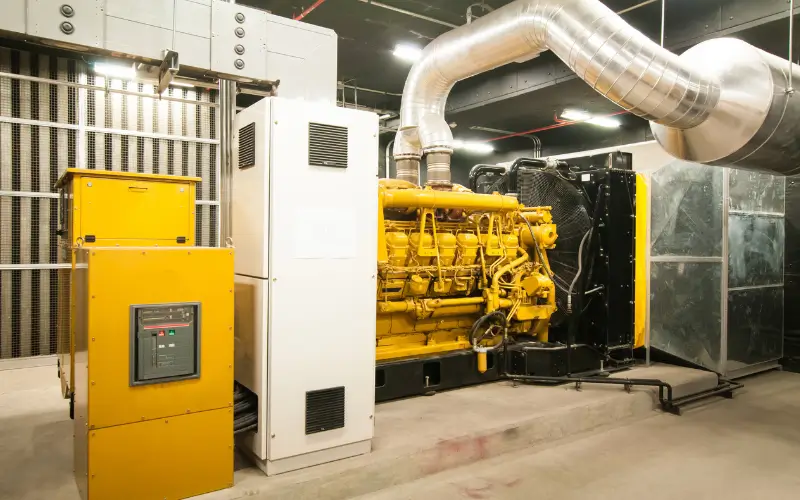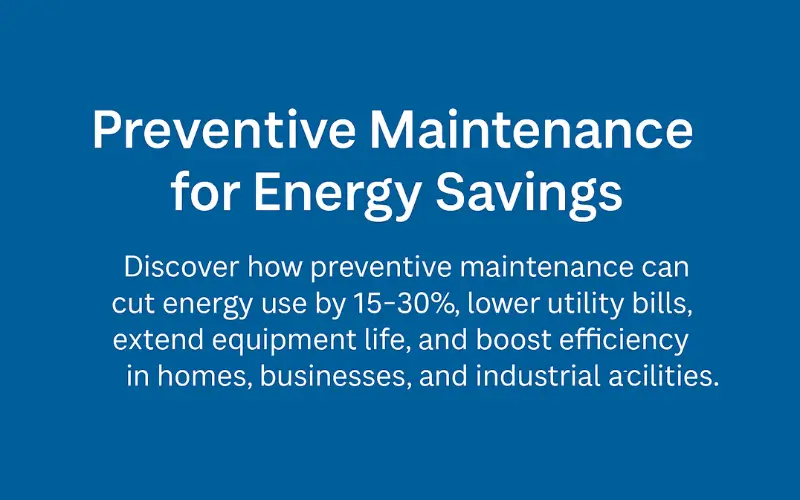Reliable power is essential for garment factories to keep production lines running smoothly. But powering machines with generators—especially diesel units—can be expensive. This is where generator efficiency becomes critically important.
Simply put, generator efficiency measures how well a generator converts fuel into usable electrical energy. The higher the efficiency, the less fuel you burn for the same amount of power, saving money and reducing your environmental impact.
For garment factories, improving generator efficiency isn’t just about lowering fuel bills. It’s about boosting profitability, ensuring uninterrupted operations during power cuts, and meeting sustainability goals demanded by international buyers.
In this comprehensive guide, we’ll explain how to measure generator efficiency, explore the factors that affect it, and share practical strategies to improve it in a garments factory setting. We’ll also look at cost savings, environmental benefits, and best practices for maintaining your generator at peak performance.
Understanding Generator Efficiency in the Garment Industry
This section breaks down the concept for factory managers, engineers, and sustainability professionals in clear, actionable language.
What Is Generator Efficiency?
Generator efficiency is a measure of how effectively a generator converts fuel energy into usable electrical power.
Mathematically, it’s usually expressed as:
Efficiency (%) = (Electrical Energy Output / Fuel Energy Input) × 100
For example, if your generator burns fuel containing 100 units of energy but only delivers 35 units as electricity, its efficiency is 35%.
Most industrial generators have efficiencies ranging from 30% to 45%, depending on design, age, and load conditions.
Understanding this efficiency is crucial because every lost percentage point represents wasted fuel, higher costs, and unnecessary emissions.
Types of Generators Used in Garment Factories
Garment factories in many regions—especially where grid power is unreliable—depend on on-site generators. Common types include:
Diesel Generators
- Most common in Bangladesh, India, and many textile hubs.
- Robust and reliable for high-load industrial use.
- Typically less efficient than natural gas but better suited to variable loads.
Gas Generators
- Fueled by piped natural gas or LPG.
- Often cleaner-burning, with slightly higher efficiencies.
- Can be economical if fuel supply is stable and affordable.
Hybrid and Bi-Fuel Systems
- Combine diesel and gas for flexibility.
- Can optimize costs and efficiency depending on fuel availability.
Each type has different efficiency characteristics. A factory must choose carefully based on operating hours, load profile, fuel costs, and environmental goals.
Why Efficiency Matters for Garments Production
For garment factories, generator efficiency isn’t just a technical curiosity—it’s a business imperative:
Cost Savings
- Fuel is one of the biggest operating costs for on-site power.
- Improving efficiency reduces fuel consumption, sometimes by 10–20%.
Production Reliability
- Efficient generators handle variable factory loads better.
- Fewer breakdowns and less downtime during grid outages.
Environmental Impact
- Burning less fuel cuts CO₂ emissions.
- Many brands now demand documented sustainability improvements from suppliers.
Competitive Advantage
- Lower operating costs mean more competitive pricing.
- Compliance with green standards can win more orders from global buyers.
How to Measure Generator Efficiency in Garment Factories
This is the practical core of the article—showing factory managers and engineers exactly how to assess efficiency in their own operations.
Basic Efficiency Formula and Units
Generator efficiency is calculated using the ratio of useful electrical energy output to the total fuel energy input.
Standard formula:
Efficiency (%) = (Electrical Output Energy / Fuel Input Energy) × 100
Electrical Output Energy is measured in kilowatt-hours (kWh).
Fuel Input Energy is the energy contained in the fuel consumed (often calculated using fuel consumption in liters or cubic meters and the fuel’s energy content in MJ or kWh).
For diesel fuel, for example, the energy content is typically ~36–38 MJ/liter (~10 kWh/liter).
Example Calculation:
If your generator uses 100 liters of diesel in one shift:
- Energy Input = 100 × 10 kWh = 1,000 kWh
- Measured Electrical Output = 350 kWh
- Efficiency = (350 / 1,000) × 100 = 35%
Step-by-Step Measurement Procedure
Below is a factory-friendly, practical approach to measuring generator efficiency:
Step 1: Measure Fuel Consumption
- Track fuel use over a set period (e.g., per shift or per day).
- Use calibrated fuel flow meters if available.
- Alternatively, measure the volume filled and consumed between refills.
Step 2: Record Electrical Energy Output
- Check the generator’s built-in kWh meter (most industrial gensets have this).
- Log total kWh generated in the same period you measured fuel.
- For more accuracy, install external metering systems.
Step 3: Convert Fuel Consumption to Energy Input
Use standard energy content values for your fuel.
- Diesel ≈ 10 kWh/liter.
- Natural gas ≈ 11 kWh/m³ (varies by supplier).
Multiply volume consumed by energy content.
Step 4: Calculate Efficiency
Use the efficiency formula:
- (kWh Output / kWh Input) × 100
Example:
- Diesel used: 120 liters
- Output: 420 kWh
- Input: 120 × 10 = 1,200 kWh
- Efficiency = (420 / 1,200) × 100 = 35%
Tools and Equipment for Measuring Efficiency
While you can do manual calculations, modern tools make the process easier and more precise:
Fuel Flow Meters
- Inline meters measure real-time fuel use.
- Allow precise tracking over any period.
- Essential for large factories wanting consistent monitoring.
Load Banks
- Artificial loads used to test generators at various loads.
- Help measure true output under controlled conditions.
- Useful for verifying rated efficiency vs. actual field performance.
Digital Monitoring Systems
- Integrated systems with sensors for fuel, power output, temperature, load factor.
- Provide dashboards with efficiency data.
- Support maintenance scheduling and efficiency benchmarking.
Factors Affecting Generator Efficiency in Garments Factories
Understanding what influences generator efficiency is essential for any garment factory that wants to reduce fuel costs, avoid downtime, and meet sustainability targets. Below, we’ll explore the main factors that affect how efficiently your generator converts fuel into usable electrical power.
Load Factor and Partial Load Operation
Generators are designed to operate most efficiently at or near their rated capacity (often 70–100% load).
Low Load (Underloading):
- Running at very low load (e.g., 20–30%) causes poor fuel efficiency.
- Fuel is burned but power output is low, lowering overall efficiency.
Load Variability:
- Frequent fluctuations in load can prevent the generator from staying in its most efficient range.
- Garment factories with highly variable production lines may see efficiency drop unless load is managed.
Best Practice:
- Plan load distribution to keep the generator in its optimal load range.
- Use load banks or multiple smaller generators to match varying demand.
Fuel Quality
The quality of fuel directly impacts combustion efficiency.
Contaminated or Low-Grade Fuel:
- Causes incomplete combustion.
- Leads to carbon deposits and wear.
- Increases fuel consumption per kWh generated.
Variation by Supplier:
- Energy content per liter or m³ can vary by source.
- Poor consistency makes efficiency calculations less reliable.
Best Practice:
- Buy from reputable suppliers.
- Use filtration systems.
- Test fuel batches if possible.
- Engine Age and Condition
- Generator efficiency naturally degrades over time.
Engine Age and Condition
Older Engines:
- Wear and tear reduce mechanical and thermal efficiency.
- Seals, pistons, and injectors may lose precision.
Unmaintained Engines:
- Carbon buildup and oil contamination increase friction and reduce combustion quality.
- Even a few percentage points lost in efficiency can mean big fuel costs over time.
Best Practice:
- Track age and operating hours.
- Schedule proactive overhauls or replacements.
Maintenance Practices
Regular maintenance is one of the easiest ways to keep efficiency high.
Key Maintenance Tasks:
- Oil changes
- Air and fuel filter replacements
- Injector cleaning or replacement
- Coolant system checks
- Electrical system inspections
Impact on Efficiency:
- Clean, well-tuned engines burn fuel more completely.
- Reduced risk of breakdowns that force low-load idling or emergency repairs.
Ambient Temperature and Site Conditions
Environmental factors also matter:
High Temperatures:
- Reduce air density, affecting combustion.
- Overheating can force derating (operating below rated capacity).
Dusty or Humid Conditions:
- Clog air filters faster.
- Lead to corrosion or contamination.
Altitude Effects:
- At higher elevations, thinner air reduces available oxygen for combustion.
Best Practice:
- Site generators in well-ventilated, shaded, and clean areas.
- Monitor environmental conditions and adjust maintenance schedules accordingly.
Strategies to Improve Generator Efficiency
Improving generator efficiency in garment factories isn’t just a technical exercise—it directly translates to lower fuel costs, more reliable production, and reduced environmental impact. Here’s a detailed look at proven strategies factories can use.
Regular Maintenance Schedules
Consistent maintenance is the single most important factor in sustaining high efficiency.
Oil and Filter Changes
- Dirty oil increases friction and wear.
- Clogged air and fuel filters reduce combustion quality.
- Stick to manufacturer-recommended intervals.
Injector and Fuel System Cleaning
- Prevents carbon buildup.
- Ensures even, complete fuel combustion.
Cooling System Checks
- Overheating reduces efficiency and damages components.
- Maintain proper coolant levels and radiator cleanliness.
Electrical Inspections
- Ensure connections are secure.
- Prevent voltage drops that waste fuel.
Best Practice:
- Set a detailed maintenance schedule and track all service activities to avoid missed intervals.
Load Management
Running a generator at low or highly variable load is one of the most common causes of poor efficiency in garment factories.
Avoid Underloading
- Generators are least efficient at very low load (<30–40%).
- Plan operations to consolidate loads where possible.
Load Balancing
- Distribute loads evenly across phases.
- Prevent single-phase overloading or underloading that strains the system.
Using Multiple Generators
- Consider splitting the load across multiple smaller units.
- Allows matching the generator fleet to production schedules more closely.
Best Practice:
- Analyze factory load profiles to optimize generator sizing and operation.
Fuel Quality and Supply Management
Low-quality or contaminated fuel severely reduces efficiency and increases maintenance costs.
Buy from Reputable Suppliers
Avoid fuel adulteration, which can reduce energy content.
Use Filtration Systems
- Install inline fuel filters and water separators.
- Protect injectors and combustion chambers from contaminants.
Storage Management
- Store fuel in clean, sealed tanks.
- Avoid water contamination and bacterial growth.
Best Practice:
- Test fuel batches periodically and maintain fuel tanks regularly.
Upgrading to Higher-Efficiency Models
Sometimes, maintenance alone can’t overcome the limits of old technology.
Newer Generator Designs
- Modern engines achieve higher combustion efficiency.
- Improved electronic controls optimize fuel injection.
Fuel Flexibility
- New models may support cleaner fuels or hybrid operation.
- Potential for switching to gas or bi-fuel systems.
Long-Term Savings
- While capital costs are higher, fuel and maintenance savings can quickly pay back the investment.
Best Practice:
- Conduct cost-benefit analyses before investing in new equipment.
Automation and Monitoring Systems
Digital tools help factories maintain consistent, efficient operation.
Real-Time Monitoring
- Track fuel consumption and power output continuously.
- Identify drops in efficiency early.
Load Management Automation
- Automatically balance load between generators or across production lines.
Predictive Maintenance Alerts
- Reduce unplanned downtime.
- Avoid efficiency losses from neglected service.
Best Practice:
- Invest in monitoring solutions that pay for themselves in saved fuel and maintenance costs.
Cost and Environmental Benefits of Improved Efficiency
Improving generator efficiency is more than a technical upgrade—it’s a strategic move that delivers real financial and environmental returns for garment factories. In this section, we’ll break down the key benefits in practical, quantifiable terms.
Fuel Savings Calculations
Fuel is typically the largest cost of operating on-site power in garment factories. Even small improvements in efficiency can yield significant savings over time.
Example Calculation:
- Current efficiency: 32%
- Target efficiency after improvements: 36%
- Annual fuel consumption: 100,000 liters of diesel
Fuel Savings Estimate:
- Improved efficiency = ~10–12% less fuel needed for same power output.
- Potential savings = 10,000–12,000 liters annually.
- At $1 per liter, that’s $10,000–$12,000 per year.
Key Benefits:
- Reduces direct fuel purchase costs.
- Cuts transportation and storage expenses.
- Eases strain on working capital.
Best Practice:
- Track efficiency over time to measure ROI on maintenance and upgrades.
CO2 Emissions Reduction
Diesel generators are significant sources of greenhouse gas emissions.
Typical Emissions Factor:
- About 2.68 kg of CO₂ per liter of diesel burned.
Using the Fuel Savings Example:
- 10,000 liters saved = ~26.8 metric tons of CO₂ avoided per year.
Why It Matters:
- Many garment brands now require suppliers to track and reduce their carbon footprint.
- Demonstrating emissions reductions can strengthen partnerships and improve audit scores.
Best Practice:
- Include generator efficiency improvements in sustainability reporting and certifications.
Impact on Overall Utility Costs
- In many regions, garment factories rely on generators for hours or even entire shifts daily due to unreliable grid power.
Electricity Cost Comparison:
- Grid electricity: ~$0.08–$0.12 per kWh.
- Diesel-generated power: ~$0.20–$0.40 per kWh, depending on fuel price and efficiency.
Improved Efficiency Lowers Effective Cost:
- Every % improvement in efficiency reduces the cost gap between grid and self-generated power.
- Can make factories more competitive in tight-margin export markets.
Secondary Savings:
- Lower maintenance costs from better engine condition.
- Fewer unplanned breakdowns and production halts.
Sustainability Goals for Garment Brands
Many global apparel brands demand that their suppliers meet specific sustainability criteria.
Common Requirements:
- Energy efficiency targets.
- CO₂ emissions reporting.
- Certifications like ISO 50001 (Energy Management Systems).
How Generator Efficiency Helps:
- Reduces energy intensity per garment produced.
- Cuts Scope 1 emissions from direct fuel use.
- Supports compliance with buyer requirements.
Competitive Advantage:
- Brands favor suppliers with documented, verifiable sustainability improvements.
- May unlock access to new orders and premium pricing.
Best Practices and Industry Standards
Achieving and maintaining high generator efficiency isn’t a one-time project—it’s an ongoing commitment. By adopting industry best practices and aligning with recognized standards, garment factories can ensure consistent performance, cost savings, and compliance with buyer requirements.
Benchmarks for Generator Efficiency
Understanding typical efficiency ranges helps you set realistic targets and identify underperforming units.
Diesel Generators:
- Typical efficiency: 30–40%
- New, well-maintained units: ~35–40%
Gas Generators:
- Efficiency often slightly higher: 35–45%
- Cleaner combustion improves thermal efficiency
Factors Influencing Benchmarks:
- Load factor (best at 70–100% load)
- Engine design and age
- Maintenance history
Best Practice:
- Compare your generator’s measured efficiency to industry benchmarks. If it’s significantly below, investigate and address causes.
- Compliance with Local Regulations
- Many countries are tightening regulations on generator emissions and fuel quality.
Examples of Regulations:
- Emissions limits (NOx, CO, PM) for industrial generators.
- Fuel sulfur content restrictions.
- Noise limits in urban or industrial zones.
Risks of Non-Compliance:
- Fines and legal penalties.
- Forced shutdowns or restrictions on use.
- Reputational damage with buyers.
Best Practice:
- Stay updated on local environmental rules. Invest in compliant equipment and fuels.
Energy Audit Guidelines
Energy audits are structured evaluations of energy use and efficiency across your facility—including generators.
Benefits of an Audit:
- Identifies inefficiencies and cost-saving opportunities.
- Benchmarks performance.
- Supports sustainability reporting.
Typical Audit Steps:
- Collect fuel and power data over time.
- Measure generator efficiency under different loads.
- Analyze load profiles and sizing.
- Recommend maintenance or upgrades.
Audit Standards:
- ASHRAE Level 1–3 audits (general industry standard).
- Country-specific energy efficiency guidelines.
Best Practice:
- Schedule regular energy audits (e.g., annually) to track efficiency improvements.
ISO 50001 or Other Certifications
Global buyers increasingly expect suppliers to demonstrate robust energy management.
What Is ISO 50001?
- International standard for Energy Management Systems (EnMS).
- Focuses on continuous improvement in energy performance.
Key Features:
- Systematic tracking of energy use.
- Setting and achieving efficiency goals.
- Documenting and verifying results.
Benefits for Garment Factories:
- Credible proof of sustainability efforts.
- Potential cost savings across all utilities.
- Competitive advantage in winning contracts with eco-conscious brands.
Other Relevant Certifications:
- LEED for industrial buildings.
- Country-specific green manufacturing certifications.
Best Practice:
- Consider adopting ISO 50001 to formalize and showcase your commitment to energy efficiency.
Case Studies or Examples
Case studies bring theory to life. For garment factories, seeing how others have improved generator efficiency—and what results they achieved—can offer practical guidance and inspiration.
Example: Generator Efficiency Upgrade at a Mid-Sized Garment Factory in Bangladesh
Factory Profile:
- Location: Gazipur, Bangladesh
- Size: 700 machines, 1,200 workers
- Generator Setup: 2 × 500 kVA diesel generators
- Average daily runtime: 10–12 hours (due to frequent grid outages)
The Problem
The factory faced high monthly diesel bills and noticed black smoke during generator operation—an early sign of inefficiency. An internal review revealed:
- Load fluctuation between 20–60%
- No recent maintenance history
- Use of low-grade diesel from an unreliable supplier
- No monitoring system in place
The Solution
Management implemented a 3-month generator efficiency improvement program:
Step 1: Maintenance Overhaul
- Replaced oil, air, and fuel filters
- Cleaned fuel injectors and exhaust system
- Serviced radiator and coolant system
Step 2: Load Management
- Shifted certain machines to daytime (when grid was more stable)
- Used both generators in parallel to match load more precisely
Step 3: Fuel Upgrade
- Switched to high-quality diesel
- Installed pre-filters in the fuel supply line
Step 4: Monitoring System Installed
- Added digital fuel meters and kWh counters
- Daily tracking of load factor and fuel consumption
Before-and-After Data
| Metric | Before | After 3 Months |
| Avg. Generator Efficiency | 31% | 38% |
| Diesel Consumption/Month | 32,000 liters | 26,800 liters |
| Monthly Diesel Cost | $32,000 | $26,800 |
| Estimated CO₂ Emissions | 85.7 tons | 71.8 tons |
Lessons Learned
Maintenance Pays Off:
- Simple servicing improved combustion, reduced smoke, and immediately boosted performance.
Smart Load Planning Matters:
- Balancing loads and avoiding underloading made a big difference in fuel efficiency.
Monitoring Enables Action:
- Real-time data helped managers take corrective actions faster and maintain improvements.
Supplier Choice Is Critical:
- Switching to cleaner, more consistent diesel improved burn quality and reduced clogging.
Conclusion
Measuring and improving generator efficiency is essential for garment factories striving to reduce costs, enhance reliability, and meet growing sustainability demands.
By understanding the fundamentals of generator efficiency, carefully measuring fuel consumption and power output, and managing key factors like load, fuel quality, and maintenance, garment factories can achieve meaningful fuel savings and cut harmful emissions.
Implementing proven strategies—such as regular maintenance, smart load management, and investing in monitoring technology—helps factories maintain optimal performance over time.
Beyond operational benefits, improved generator efficiency strengthens your factory’s environmental credentials, making it more attractive to global apparel brands focused on sustainability.
As power generation often represents a significant share of factory operating costs, continuous attention to generator efficiency is a smart investment that pays off financially and environmentally.
Frequently Asked Questions (FAQs)
Q1: What is a good generator efficiency percentage for garment factories?
A: Most diesel generators operate between 30% and 40% efficiency. A well-maintained, properly loaded generator can reach up to 40%. Efficiency below 30% usually indicates problems that need addressing.
Q2: How do I calculate my generator’s efficiency?
A: Measure the electrical energy output (in kWh) over a period and the fuel consumed (converted to energy units). Then use the formula: Efficiency (%) = (Output Energy / Input Energy) × 100.
Q3: How often should generators in garment factories be serviced?
A: Regular servicing every 3-6 months is recommended, depending on usage hours and manufacturer guidelines. Critical tasks include oil and filter changes, injector cleaning, and cooling system checks.
Q4: Can automation improve generator efficiency?
A: Yes, automation systems help monitor fuel use, balance loads, and schedule maintenance proactively, all of which enhance overall efficiency and reduce fuel waste.
Q5: What are the environmental benefits of improving generator efficiency?
A: Better efficiency reduces fuel consumption and greenhouse gas emissions such as CO₂, helping factories meet sustainability targets and reduce their carbon footprint.
Q6: Is it worth upgrading an old generator?
A: Often yes. Newer generators offer better fuel economy, lower emissions, and advanced controls that can lead to significant long-term cost savings despite initial investment.
Q7: What tools do I need to measure generator efficiency accurately?
A: Essential tools include fuel flow meters, kWh meters, load banks for testing, and digital monitoring systems that provide real-time data for precise efficiency calculations.




